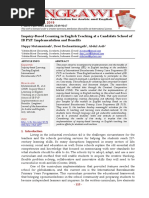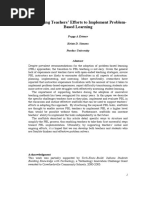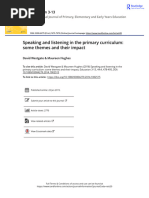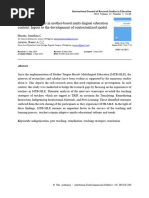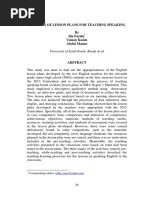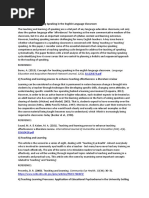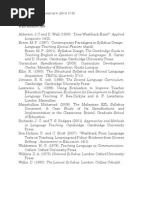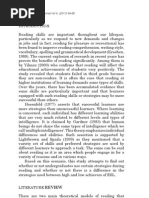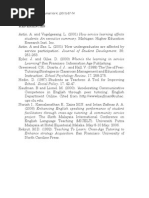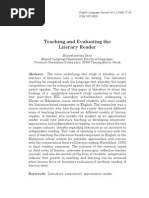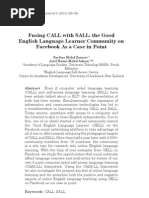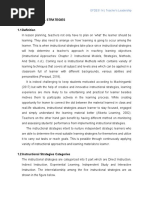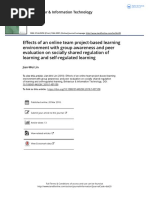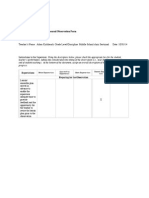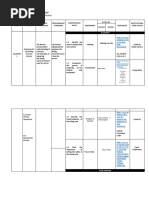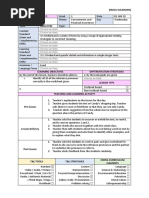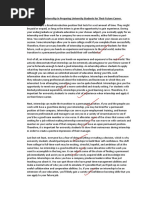English Language Journal Vol 4, (2011) 99-113 ISSN 1823 6820
English Language Journal Vol 4, (2011) 99-113 ISSN 1823 6820
Uploaded by
Mohd Zahren ZakariaCopyright:
Available Formats
English Language Journal Vol 4, (2011) 99-113 ISSN 1823 6820
English Language Journal Vol 4, (2011) 99-113 ISSN 1823 6820
Uploaded by
Mohd Zahren ZakariaOriginal Title
Copyright
Available Formats
Share this document
Did you find this document useful?
Is this content inappropriate?
Copyright:
Available Formats
English Language Journal Vol 4, (2011) 99-113 ISSN 1823 6820
English Language Journal Vol 4, (2011) 99-113 ISSN 1823 6820
Uploaded by
Mohd Zahren ZakariaCopyright:
Available Formats
English Language Journal Vol 4, (2011) 99-113 ISSN 1823 6820
INTRODUCTION
In recent years, the Malaysian government has advocated the idea of a developed nation by capitalizing and enhancing in human capital. Malaysia has invested heavily in education and training where efforts have been made to ensure that the training and education delivery system remain relevant, responsive and flexible to meet the changing needs and challenges within the context of globalization (BERNAMA). In the attempt to meet with the above demands, there is a need for the Ministry of Higher Education (MOHE) to ensure that quality education, training and lifelong learning are achieved at all educational levels. In line with this effort, in August 2006, the Minister of Higher Education, Dato Mustapha Muhammad had launched the Soft Skills module and workshop for Higher Education in Malaysia. With the onset of this new module, the higher institutions in Malaysia were urged to review their curriculum and to incorporate soft skills into their programmes and courses. This is hoped to strengthen the undergraduates soft skills which comprise elements of thinking skills, communication skills, leadership qualities, communication skills, team work, lifelong learning, and ethics and professionalism. Consequently, lecturers at higher institutions were also urged to embark on innovations and change their styles of teaching from the lecturer-centered to more of student-centered learning (SCL) approach. Among the teaching approaches and techniques known that can foster SCL are problem-based learning, modular approach, case study and project oriented problem based learning. The incorporation of SCL approach in teaching and learning has brought about some changes in the way the student teachers project paper course was carried out at the institution which seems to be the focus of this study. The aims of this article are twofold: firstly, it intends to shed light on the types of learning that occur by adopting and adapting the problem-based learning approach in engaging English as a Second Language (ESL) student teachers in classroom research. Secondly, it aims to discuss the problems and challenges that the student teachers faced while conducting their studies.
100
English Language Journal Vol 4, (2011) 99-113 ISSN 1823 6820
PROBLEM BASED LEARNING APPROACH (PBL)
Problem-based learning (PBL) is an approach that is originated from the medical science field and has proven to be an effective tool to facilitate medical students in their process of learning (Bransford et al., 1999; as cited in Wee & Kek, 2004). This approach has becoming increasingly in favour in other disciplines especially in promoting studentcentered and independent learning. There has also been a lot of discussion based on the implementation of PBL and the possibilities of its execution (Boud and Feletti, 1997; Glen and Wilkie, 2000; Duch et al. 2001; as cited in Savin-Baden, 2003). Despite various terms and definitions of PBL approach, it is fundamentally being defined as a curriculum model that is designed around real-life problems that are ill-structured, open-ended or ambiguous (Fogarty, 1997; as cited in Wu and Forrester, 2004). Besides this definition, the PBL approach can also easily be identified by several common features as follows: a. All PBL approaches start with a problem or question (Duffy & Cunningham, 2006; Grabinger, 1996). b. The process of PBL involves clarification, definition with reframing, analysis and summary with synthesis (Tan, 2003). c. Students assume primary responsibility for analyzing the problem and making inquiry (Slavin, Madden, Dolan & Wasik, 1994). d. The teachers role is primarily facilitative (Stephen & Gallagher, 1993). (Wu & Forrester, 2004:64) In addition, through PBL, students will become independent enquirers as learning is stimulated through the concepts that are brought out by the problems (Savin- Boden, 2003, Spronken-Smith, 2005). These problems have to be relevant to professional practice to enable students to explore the problem, reason out and apply knowledge (Barrows & Tamlyn (1990), as cited in Spronken-Smith, 2005). PBL is also a model that encourages critical contestability (Savin-Boden, 2000) before agreeing to a particular or various solutions.
101
English Language Journal Vol 4, (2011) 99-113 ISSN 1823 6820
THE RATIONALE FOR USING PBL APPROACH
Advocates of PBL approach affirm that this approach has several advantages related to methodology of teaching and learning. Murray-Harvey et al. (2005:257) outline several reasons why PBL can be an effective method for teacher education programmes: (i) PBL promotes a deep rather than surface approach to learning (Biggs, 1999); (ii) it encourages higher order thinking; (iii) it fosters self-direction in learning and the development of meta-cognitive skills and strategies (Hmelo-Silver, 2004); (iv) creates more stimulating learning environments; (v) increases collaborative interaction between student and teachers; (vi) improves motivation; and finally, increases knowledge retention (Spencer & Jordan, 1999). In addition, the PBL approach reflects the constructivist perspectives in which the process of learning meaning is not transmitted during direct instruction. Instead, meaning is created by students learning activities (Spronken-Smith, 2005). By being engaged in a particular activity, students will develop a personal presentation of knowledge and construct their own views of the subject and the world (Bryson and Hand, 2007). PBL also can serve as a medium to engage students in a community of practice (Wenger, 1998) that will encourage them to become active agents of enquirers. This is seen of paramount importance to get student teachers to be involved in research projects that seem to be part and requirement of many teacher education programmes. PBL can assist students to develop the ability to carry out research by getting them to learn and assess ways that reflect the research processes such as through collaborative inquiry: working on real-world problems and writing a thesis project. Through the PBL activities they will be indirectly equipped with relevant research skills and knowledge (Jenkins et al., 2003: as cited in Spronken-Smith, 2005).
THE TEACHING & LEARNING CONTExTS USING
PBL
The participants of this study consisted of 47 ESL student teachers: 39 pre-service and 8 in-service student teachers.
102
English Language Journal Vol 4, (2011) 99-113 ISSN 1823 6820
Project Paper is a core course and a final project that student teachers usually enroll in their final year before leaving for their teaching practice. The data for this study were collected through questionnaires, open observations, field notes and document analysis. The course was carried out in one semester (14 weeks) with 3 contact hours per week. The objectives of the project were to enable student teachers to: a. identify a common problem among their participants based on the problem scenarios given on five types of language skills and write a research proposal; b. select suitable research methods and carry out the project by solving the problems that they have identified; c. collect and analyse the data gathered; d. interpret data and draw conclusions; and e. write a research project report. At the beginning of the course, the student teachers were exposed to the PBL concept and approaches in educational research. The student teachers were given five problem scenarios and each of the problem scenario depicts general problems on one particular language skills such as reading, listening, speaking, writing and including aspects like grammar and vocabulary. The students were required to choose a problem scenario that they would like to work on. They have to work individually for the completion of the project. Nevertheless, all discussions during lectures were done in groups or as a whole class discussion. To further probe into the learners problems within the problem scenario chosen, the student teachers were to design a questionnaire that would inform them the real problems that the learners faced from the learners perspectives at the school that they would carry out their study. A workshop was carried out on how to design questionnaire and samples of the questionnaires designed by the student teachers were presented and discussed for improvements before they were given to the learners in schools. Each student teacher was given a group of students as their participants at a designated school. There were three
103
English Language Journal Vol 4, (2011) 99-113 ISSN 1823 6820
schools which participated in the study and they were all within the vicinity of the university and administered by the same Education District Department. The rationale for determining the research sites for the student teachers was that getting access to schools and classrooms can be quite a tedious and long winded process in the Malaysian context. The student teachers distributed the questionnaires to the learners in schools and analysed them. They were to carry out a brief presentation on their findings and the problems that they had investigated. Based on the problems identified from the questionnaire, the student teachers were required to design a diagnostic test to gauge the learners level of difficulties in that particular problem area. This also served as a triangulation for the data gathered from the questionnaire. The answers in the diagnostic test should reflect the problems that the learners have indicated in the questionnaire. If there were to be any differences, this would indicate that either the learners were not truthful when answering the questionnaire or they were not able to identify their own weaknesses in that particular language skill. In the next stage the student teachers were to determine the appropriate task-based activities to solve the learners problems. Due to the limitation of time, student teachers were to carry out only four task-based activities with the learners. In this process, their activities were designed progressively in which the first activity would determine the design of the second activity and the following activities. The task-based activities could not be prepared in advance until the taskbased activity one had been evaluated and analysed. The design of the following task based activities need to take into account the problems that learners had in the previous taskbased activity. Among the methods used by the student teachers in their process of collecting the data were observation checklist, interview session with the learners and feedback form. However, the choice of methods used was based on the student teachers preference and its role in collecting the data. For instance, some student teachers use the observation checklist to study their learners participation while others
104
English Language Journal Vol 4, (2011) 99-113 ISSN 1823 6820
gathered similar data either through interview session or distribution of feedback form at the end of the task-based activity sessions. All the student teachers were required to keep a research diary that aimed to assist them in the process of collecting the data. While this process was carried out independently outside of the lecture hours, the student teachers were to attend lectures where discussions and workshops were held to assist them in the process of writing their chapters and to get them to discuss their progress and findings. This session was carried out stage by stage from writing their proposals at the beginning to writing their conclusions. Samples from the student teachers work were discussed, commented and given feedback. At the end of the semester, the student teachers were to share their findings through poster presentations. THE KINDS OF LEARNING THAT STUDENTS ENGAGE IN THROUGH ADAPTING THE PBL APPROACH IN THEIR PROJECT WORK The data from the questionnaire distributed to the student teachers at the end of the semester were analysed quantitatively by calculating the frequency counts. In addition, data from observations and research diary were analysed qualitatively by coming up with categories and themes. It was found that student teachers had engaged in various kinds of learning while doing their project using the adapted PBL approach as discussed in the following paragraphs.
Identifying Learners Problems
Upon deciding on the problem scenario that they wanted to work on, student teachers noticed the various problems in general that emerged from the questionnaire distributed to their learners. Many student teachers chose the problem scenario on writing as they felt that this was among the skills that many learners in schools have difficulties to master. Although all PBL approaches start with a problem or question (Duffy & Cunningham, 2006; Grabinger, 1996),
105
English Language Journal Vol 4, (2011) 99-113 ISSN 1823 6820
the student teachers had also noticed that learners in schools had multiple problems and due to that the student teachers had to choose the core problem to work on among the majority of these learners. They also noticed that these learners had mixed abilities and language proficiencies. The student teachers learned to clarify their initial understanding of the problems and therefore, used the questionnaires and diagnostic test to focus on one particular aspect of problem encountered by all learners. While doing this, the student teachers engaged themselves in higher order thinking as they needed to select the exact problem and make decision based on the data that they had. Biggs (1999) indicates that PBL approach promotes deep rather than surface structure of learning and this can be seen quite apparent through the activities that they had gone through. The majority of the student teachers, 27 out of 47, stated that they had problems with designing the questionnaires. My observation during the classroom workshop revealed that some student teachers did not read or review sources pertaining to the problem scenario chosen. Therefore, they constructed general questions or statements that did not probe into the common problem shared among their participants. On the other hand, student teachers who read and knew the skills and sub-skills in the problem scenario that they had chosen seemed to be able to construct better questions and statements. Their questionnaires were more organized and rigorous as compared to those who did not read on the chosen problem scenario. However, the student teachers indicated that the samples, advices, feedback and suggestions given in the workshop session had helped them to write precise questions, gave them ideas to create statements and improved on their questions. Their course mates comments and feedback given during the workshops had also helped them to improve on their own questionnaires.
Engaging Themselves in Real Teaching and Learning
Context By being in situ with their learners, the student teachers were able to engage themselves in real communication and
106
English Language Journal Vol 4, (2011) 99-113 ISSN 1823 6820
deal with real teaching and learning problems. They were able to develop a personal presentation of knowledge that they had gathered and constructed their own views of the content subject as well as on the teaching and learning process (Bryson and Hand, 2007). Most of the student teachers rated the success of them designing the task based activities as average. They argued that the limited time frame to carry out the study did not allow them to design good task based activities. Some also felt that their learners needed more time, especially for clarification and explanation during their meetings. Those who rated the success of them designing the task based activities as excellent were satisfied with their learners improvement and their own abilities to solve their learners learning problems in the problem scenario that they have chosen. Similar to above findings, most student teachers rated the success of them carrying out the task based activities as average. They felt that they had to deal with many unexpected problems during the sessions. Some also realized that they were not able to manage their learners well and did not probe further into the problems that their learners had. However, on a positive note, they felt that they could improve on how they carried out the task based activities especially when giving instructions and explanations. Despite all the problems that the student teachers had, 46 of them indicated that they enjoyed the process of designing and carrying out the activities with their learners. Only one person indicated that he did not enjoy those sessions. Many of the student teachers revealed that they benefited from the sessions that they had with their learners. They reasoned out by commenting that those sessions had made them realized that different learners would have different learning styles; they gained teaching experience by engaging themselves with real learners in a classroom environment; they were able to try out certain techniques and investigated the strengths and weaknesses; and they were able to know and understand the learners problems first hand. Some examples from the questionnaires are shown below:
107
English Language Journal Vol 4, (2011) 99-113 ISSN 1823 6820
Got to do hands-on approach and assess the level of students understanding. (P18009) I can observe and monitor their performances in their actual environment and guide them in all the processes so that they can produce genuine results for the data collected. (P18019) The sessions exposed me in dealing with the students and their needs. This is important as a future teacher. (P18032) Engaging in the Process of Evaluating, Reflecting and
Reiterating By carrying out the study and adopting the PBL approach, the student teachers were engaged in the process of evaluating, reflecting and reiterating the activities while trying to solve the learners problems. They learned to critically evaluate the outcome of each of their activities before deciding on what kind of activities that they should introduce to the learners. This is in support of the PBL model that encourages critical contestability (Savin-Boden, 2000) before agreeing to a particular or various solutions. The student teachers revealed that their first presentation on the findings of the questionnaire was beneficial as most of them indicated that they learned from the feedback given after each presentation; they were able to check their mistakes, made amendments and planned for the next stage. The presentation also helped them to refine their own research questions. In addition, the presentation provided them with a platform to listen to other peoples ideas and opinions. They also indicated that such presentations helped them to clarify their thoughts with other course mates and lecturer.
The opinions shared by my course mates helped me to look at my own work from another point of view. It helped me to improve on my research. (P18025)
108
English Language Journal Vol 4, (2011) 99-113 ISSN 1823 6820
The continuous workshops that were carried out during tutorials were seen as beneficial by the student teachers in the process of writing the project paper. They were able not only to evaluate and reflect on their own work but also to clarify their understandings by listening to other people ideas and comments and also sharing their own thoughts. As they indicated:
I get to learn how to answer my research questions and discuss my findings. I also learnt how to support my discussion with other researchers work. (P18036) I gained input on how to shape my final report and I was able to identify what was lacking in my project paper. (P18012) Sharing and Presenting Ideas
By adopting the PBL approach, the student teachers are encouraged to share their ideas with their course mates during the workshop sessions. The process of creating meaning through the sessions are being enhanced with the use of dialectical activity (Hmelo and Evenson, 2000; as cited in Murray-Harvey et al., 2005) where own meaning is clarified and contested with the meaning created and understood by other peers and lecturer. The student teachers were required to engage themselves in group discussion and collaborative learning in their attempts to complete their projects. This sort of platform did not only provide the opportunity of sharing and exchanging ideas but also provide support that learning is not an isolated, individual activity (Kelly & Green, 1998; Wenger, 1998; Murray-Harvey et al., 2005) that is disconnected from learning by other peoples experiences and how they made sense of certain ideas and concepts. The poster presentation at the end of the course had also provided them with the platform to share and explain their findings with other course mates and lecturers. This gave them a sense of achievement and helped them build their confidence as well as improved communication skills in sharing and disseminating their findings. Among the comments written were:
109
English Language Journal Vol 4, (2011) 99-113 ISSN 1823 6820
I got lots of benefits from my friends presentation where I was able to extend my understanding of the learning problems faced by the Malaysian learners. (P18023) I learnt to present my work in an academic way. (P18030) It was like a summary of the whole research, I got to listen to various research topics and learnt about the different approaches used and what the researchers found out from their studies. (P19492) Assuming Primary Responsibility of Their Study
By engaging in the process of doing the research, the student teachers had to assume primary responsibility for analyzing the problem and making further enquiries as the lecturer did not observe them while they were in schools. They had to create meaning on how to go about conducting the activity and probed further into problem solving activities. In addition, they also had to find relevant literature in the problem scenario that they have chosen to support their discussions. The lecturers role is primarily facilitative in the sense that whatever activities that were designed and carried out were discussed during lectures and tutorials. Even so, this did not mean that they were able to discuss their project during every lecture because turns to discuss ones project had to be distributed equally and shared with other course mates. To support them in their research activities, each student teacher was assigned with a supervisor for consultation purposes.
LIMITATIONS IN ADOPTING THE PBL APPROACH THROUGH CLASSROOM RESEARCH
Although the student teachers were able to identify some of the problems from the problem scenario given, they stated that they found difficulties in constructing the questionnaire that would lead them to identify the common problem among
110
English Language Journal Vol 4, (2011) 99-113 ISSN 1823 6820
their participants. Furthermore, some indicated they could not predict what sort of problems that learners faced in the area. This problem was anticipated earlier by the lecturer as most of them were pre-service teachers who did not have any teaching experience. Majority of the student teachers, 38 out of the 47, had no problems following the PBL process. Following the process was seen as important because the process allowed them to reiterate the problems and engaged them in deep thinking when searching for solutions to the problems. Many of them indicated that once they were able to identify the problem, they were also able to think of the teaching strategies and activities that would help solved the problems. However, there were 8 of the student teachers who thought of the teaching strategies first before designing the questionnaire because they felt that it would be easier if it was done that way. Another 4 student teachers thought of the activities first because they felt it was important to prepare the activities in advance. As this occurred at the beginning of the semester, it was quite apparent that some student teachers were still struggling to understand the concept of PBL approach despite the briefing that was given in the first week of the semester. These student teachers were confused because they were relying on their past experiences doing school based study without realizing that this project required them to adopt a different kind of approach. However, the workshop sessions were useful to get them back on track. There were mainly three types of research diary written by the student teacher. Firslyt, they were written in the form of a diary entry. Secondly, in the form of columns that consisted of details on the dates of the diary entries, action plans, arising matters and follow-up activity. This form seemed to be the choice of many student teachers for their research diaries. Thirdly, it was found that one student teacher used the mind-mapping techniques as a form of research diary. However, the analysis of the research diaries revealed that the student teachers mostly used them for the purpose of reporting their activities and not as means of clarifying, justifying or brainstorming their thoughts and
111
English Language Journal Vol 4, (2011) 99-113 ISSN 1823 6820
decisions. There were no spontaneity of decision-making or planning discussed in the research diary. The research diary did not exhibit any critical and creative thinking as most of them were merely reporting.
CONCLUSION
The Problem Based Learning (PBL) approach used in the student teachers project paper course illuminates several insights that are worth taking into consideration when deciding to embark on this approach. The approach lent itself to the process of discovery learning in which student teachers were required to look for solutions to their learners problems and these solutions were not always straightforward and required them to be thinking out of the box. They had to use their critical thinking skills when faced with problematic situations in their attempts to arrive at several options when providing solutions. Making a correct decision was seen as necessary in order to arrive at good solution. It also taught the student teachers to become independent inquirers and learners, which is seen as a vital skill in their preparation of becoming efficient teachers. The nature of the PBL approach also encouraged sharing of ideas and learning by listening to other peers through the workshop sessions. In this way, student teachers learned to clarify their thoughts, contest their ideas, receive opinions and comments as well as give opinions and feedback to others. Therefore, the project has to be carefully planned by lecturers in order to provide platforms for student teachers to develop the above skills. Since the project was carried out at its infancy, there were several problems that were highlighted in the implementation of the PBL approach especially the misconception and misunderstanding on how to go about doing the research as student teachers were relying on their past experiences of carrying out a school project. However, it was also shown that as student teachers gained their familiarity to the approach, they were able to carry out the project with more independence and they were not relying so much on the lecturer.
112
You might also like
- AI in Language Teaching Learning and AssessmentDocument407 pagesAI in Language Teaching Learning and Assessmentumit.isikliNo ratings yet
- Grade 11 DLPDocument2 pagesGrade 11 DLPjess oquendo100% (7)
- An Investigation Into The Relationship Between Teaching Methods and Academic Performance of Secondary School Students in NigeriaDocument61 pagesAn Investigation Into The Relationship Between Teaching Methods and Academic Performance of Secondary School Students in NigeriaUsman Ahmad TijjaniNo ratings yet
- Inquiry-Based Learning in English Teaching at A Candidate School of IB PYP: Implementation and BenefitsDocument12 pagesInquiry-Based Learning in English Teaching at A Candidate School of IB PYP: Implementation and BenefitsRichard WilliamsNo ratings yet
- DRAFT of K'YABOODocument17 pagesDRAFT of K'YABOOadyjrNo ratings yet
- Evaluating The Teaching Difficulties of A Physics Topic Using The Classroom Practice Diagnostic Framework (CPDF) : A Focus On Classroom Interactions and DiscourseDocument11 pagesEvaluating The Teaching Difficulties of A Physics Topic Using The Classroom Practice Diagnostic Framework (CPDF) : A Focus On Classroom Interactions and DiscourseeugenioNo ratings yet
- Chapter One 1.1 Background To The StudyDocument9 pagesChapter One 1.1 Background To The Studyhouseof comfortNo ratings yet
- 2nd Language Learners' AchievementDocument8 pages2nd Language Learners' AchievementPutraFajarNo ratings yet
- Students With Learning DifficultiesDocument5 pagesStudents With Learning DifficultiesmostarjelicaNo ratings yet
- Promblem BasedDocument11 pagesPromblem BasedAris PurwantoroNo ratings yet
- Seminar in Tefl Grup 10Document10 pagesSeminar in Tefl Grup 10LULU ALPINA DEWI UINJKTNo ratings yet
- Lesson 3Document5 pagesLesson 3Rhea Mae GastadorNo ratings yet
- Ertmer - Simons 2005 PDFDocument14 pagesErtmer - Simons 2005 PDFRodrigo GómezNo ratings yet
- EFL Teachers Attitudes and PerspectiveDocument6 pagesEFL Teachers Attitudes and PerspectiveSouad BenguegaNo ratings yet
- Language Assessment Principles - WashbackDocument8 pagesLanguage Assessment Principles - WashbackRosmalia Kasan100% (1)
- Tugasan 1 - KPD3016Document17 pagesTugasan 1 - KPD3016Awan PutihNo ratings yet
- BENLAC Module 4 Integrating New Literacies in The CurriculumDocument8 pagesBENLAC Module 4 Integrating New Literacies in The CurriculumJustine Vistavilla PagodNo ratings yet
- Travails of Out-of-Field-Teaching Qualitative InquiryDocument22 pagesTravails of Out-of-Field-Teaching Qualitative InquiryFrancis Edward BlancoNo ratings yet
- Assessment Literacy - Action ResearchDocument11 pagesAssessment Literacy - Action ResearchEmy IbrahimNo ratings yet
- Speaking and Listening in The Primary Curriculum Some Themes and Their ImpactDocument19 pagesSpeaking and Listening in The Primary Curriculum Some Themes and Their ImpactTamarNo ratings yet
- DTL Essay 1Document11 pagesDTL Essay 1api-321072334No ratings yet
- Finals Theo PaperDocument29 pagesFinals Theo PaperAdrian AtienzaNo ratings yet
- AMABAO Et. Al Chapter 1 5 FinalDocument105 pagesAMABAO Et. Al Chapter 1 5 FinalJanara WamarNo ratings yet
- Slavich&Zimbardo (2012) Transformational TeachingDocument40 pagesSlavich&Zimbardo (2012) Transformational TeachingmarnekibNo ratings yet
- Lesson 2-WPS OfficeDocument17 pagesLesson 2-WPS OfficeJohn Mark MapusaoNo ratings yet
- Arp 30Document17 pagesArp 30Emie Bajamundi MaclangNo ratings yet
- 2021 - Al-Busaidi&AlSeyabi (2021) Project-Based Learning As A Tool For Student Teachers Professional DevelopmentDocument21 pages2021 - Al-Busaidi&AlSeyabi (2021) Project-Based Learning As A Tool For Student Teachers Professional DevelopmentlidiavalNo ratings yet
- 66) VI18-1142 - Full Paper-Abigail Melad EssienDocument6 pages66) VI18-1142 - Full Paper-Abigail Melad EssienP'ng Fei MunNo ratings yet
- MOTHER TONGUEDocument8 pagesMOTHER TONGUEofelyn.lupoganNo ratings yet
- BBRC4103 Research MethodologyDocument21 pagesBBRC4103 Research MethodologyHidayah Rosman100% (1)
- Flipped LearningDocument6 pagesFlipped LearningkosaymoneerNo ratings yet
- Chapter 1-3Document14 pagesChapter 1-3Thoriq NajaNo ratings yet
- Advanced Research MethodDocument14 pagesAdvanced Research MethodUVARANI A/P RETNAM MoeNo ratings yet
- Sarahknight, Cocreation of The Curriculum Lubicz-Nawrocka 13 October 2017Document14 pagesSarahknight, Cocreation of The Curriculum Lubicz-Nawrocka 13 October 2017陳水恩No ratings yet
- 85797-Article Text-191942-1-10-20231106Document8 pages85797-Article Text-191942-1-10-20231106lengochoang06102003No ratings yet
- Intensive Reflection in Teacher Training: What Is It Good For?Document12 pagesIntensive Reflection in Teacher Training: What Is It Good For?Iara Maria MouraNo ratings yet
- Review of Related LiteratureDocument15 pagesReview of Related LiteratureZenly AlleraNo ratings yet
- My PortfolioDocument8 pagesMy PortfolioAaron WilsonNo ratings yet
- Final Action Research PplanDocument8 pagesFinal Action Research Pplanapi-528569032No ratings yet
- The Effectiveness of A Guided Inquiry-Based, Teachers' Professional Development Programme On Saudi Students' Understanding of DensityDocument24 pagesThe Effectiveness of A Guided Inquiry-Based, Teachers' Professional Development Programme On Saudi Students' Understanding of DensityRini Endwiniksfitri Rara AlwanNo ratings yet
- Research No. 1019027: Validation and Utilization of A Developed Contextualized Learning Module For Science FiveDocument15 pagesResearch No. 1019027: Validation and Utilization of A Developed Contextualized Learning Module For Science FivejoyceNo ratings yet
- Inquiry Based LearningDocument4 pagesInquiry Based LearningBrigitta AdnyanaNo ratings yet
- Analysis of Lesson Plans For Teaching SpeakingDocument14 pagesAnalysis of Lesson Plans For Teaching SpeakingLEE SobertNo ratings yet
- Implementation of Inductive Model in Eng PDFDocument6 pagesImplementation of Inductive Model in Eng PDFSri Aini SeptiaNo ratings yet
- 6 Ijesrfeb20176Document8 pages6 Ijesrfeb20176TJPRC PublicationsNo ratings yet
- Dissertation On Teacher EffectivenessDocument4 pagesDissertation On Teacher EffectivenessNeedSomeoneToWriteMyPaperForMeUK100% (2)
- Understanding Language Tests and Testing PracticesDocument24 pagesUnderstanding Language Tests and Testing Practiceseduardo mackenzieNo ratings yet
- resarch ke edit wali reportDocument16 pagesresarch ke edit wali reporteirhatariq72No ratings yet
- Teacher LearningDocument71 pagesTeacher Learningespanol.a.tu.ritmoNo ratings yet
- Research Proposal by Irm Students Real Sample 1Document14 pagesResearch Proposal by Irm Students Real Sample 12257011111No ratings yet
- Effectiveness of Cooperative Learning Approach in Developing Critical Thinking Skills of Secondary StudentsDocument9 pagesEffectiveness of Cooperative Learning Approach in Developing Critical Thinking Skills of Secondary StudentsHạnh NguyễnNo ratings yet
- Aksela Haatainen 2019 PBL in Practise Active Teachers Views of Its Advantages and ChallengesDocument8 pagesAksela Haatainen 2019 PBL in Practise Active Teachers Views of Its Advantages and ChallengesYasmin Morais RafaelNo ratings yet
- RemedialDocument5 pagesRemedialNikko Franco TemplonuevoNo ratings yet
- Ian Christian A. Febrer Amungan High School (AHS) : Republic of The Philippines Region 3 - Central Luzon Iba DistrictDocument24 pagesIan Christian A. Febrer Amungan High School (AHS) : Republic of The Philippines Region 3 - Central Luzon Iba DistrictLedor LabeNo ratings yet
- NegotiatedsyllabusDocument10 pagesNegotiatedsyllabusapi-302425883No ratings yet
- Knowledge Essay Portfolio 3Document40 pagesKnowledge Essay Portfolio 3api-292192979No ratings yet
- M.Ed. (Educational Management & Leadership) : Course Code: EDA 6701 Course Title: Education Planning & Evaluation 20%Document10 pagesM.Ed. (Educational Management & Leadership) : Course Code: EDA 6701 Course Title: Education Planning & Evaluation 20%ez77alinaNo ratings yet
- Teachers Professional Development A Theoretical ReviewDocument6 pagesTeachers Professional Development A Theoretical ReviewAnonymous PFDYgo100% (1)
- Reading Artifact Reflectionstandard7planningDocument4 pagesReading Artifact Reflectionstandard7planningapi-292471312No ratings yet
- Jurnals and BooksDocument7 pagesJurnals and BooksTESL10620 Aida Nur Athilah Binti Mat SohNo ratings yet
- Review of Related LiteratureDocument8 pagesReview of Related LiteratureArceño AnnNo ratings yet
- The Structured Method of Pedagogy: Effective Teaching in the Era of the New Mission for Public Education in the United StatesFrom EverandThe Structured Method of Pedagogy: Effective Teaching in the Era of the New Mission for Public Education in the United StatesNo ratings yet
- ReferencesDocument1 pageReferencesMohd Zahren ZakariaNo ratings yet
- English Language Journal Vol 4, (2011) 49-66 ISSN 1823 6820: ReviewDocument15 pagesEnglish Language Journal Vol 4, (2011) 49-66 ISSN 1823 6820: ReviewMohd Zahren ZakariaNo ratings yet
- Abs TrakDocument1 pageAbs TrakMohd Zahren ZakariaNo ratings yet
- Abs TrakDocument1 pageAbs TrakMohd Zahren ZakariaNo ratings yet
- Abs TrakDocument1 pageAbs TrakMohd Zahren ZakariaNo ratings yet
- Abs TrakDocument1 pageAbs TrakMohd Zahren ZakariaNo ratings yet
- Abs TrakDocument1 pageAbs TrakMohd Zahren ZakariaNo ratings yet
- ReferencesDocument1 pageReferencesMohd Zahren ZakariaNo ratings yet
- Full ArtikelDocument6 pagesFull ArtikelMohd Zahren ZakariaNo ratings yet
- Abs TrakDocument1 pageAbs TrakMohd Zahren ZakariaNo ratings yet
- English Language Journal Vol 4, (2011) 114-125 ISSN 1823 6820Document11 pagesEnglish Language Journal Vol 4, (2011) 114-125 ISSN 1823 6820Mohd Zahren ZakariaNo ratings yet
- Abs TrakDocument1 pageAbs TrakMohd Zahren ZakariaNo ratings yet
- Abs TrakDocument1 pageAbs TrakMohd Zahren ZakariaNo ratings yet
- Abs TrakDocument1 pageAbs TrakMohd Zahren ZakariaNo ratings yet
- Abs TrakDocument1 pageAbs TrakMohd Zahren ZakariaNo ratings yet
- ReferencesDocument1 pageReferencesMohd Zahren ZakariaNo ratings yet
- English Language Journal Vol 3, (2009) 125-142 ISSN 1823 6820Document15 pagesEnglish Language Journal Vol 3, (2009) 125-142 ISSN 1823 6820Mohd Zahren ZakariaNo ratings yet
- Abs TrackDocument1 pageAbs TrackMohd Zahren ZakariaNo ratings yet
- Full ArtikelDocument8 pagesFull ArtikelMohd Zahren ZakariaNo ratings yet
- English Language Journal Vol 3, (2009) 39-56 ISSN 1823 6820Document14 pagesEnglish Language Journal Vol 3, (2009) 39-56 ISSN 1823 6820Mohd Zahren ZakariaNo ratings yet
- Full ArtikelDocument10 pagesFull ArtikelMohd Zahren ZakariaNo ratings yet
- ReferencesDocument1 pageReferencesMohd Zahren ZakariaNo ratings yet
- Abs TrakDocument1 pageAbs TrakMohd Zahren ZakariaNo ratings yet
- Abs TrakDocument1 pageAbs TrakMohd Zahren ZakariaNo ratings yet
- Lesson 24Document2 pagesLesson 24teacherazuraNo ratings yet
- 3rd PowerPoint StoryDocument3 pages3rd PowerPoint StorymrdeisslerNo ratings yet
- 1.0 Instructional Strategies: EFDE3114 - Teacher's LeadershipDocument7 pages1.0 Instructional Strategies: EFDE3114 - Teacher's LeadershipHanNo ratings yet
- 21st Century AssessmentDocument31 pages21st Century AssessmentNette Tolentino del RosarioNo ratings yet
- DLL - Enrichment - Q1-Week 1Document2 pagesDLL - Enrichment - Q1-Week 1Danilo LagascaNo ratings yet
- Lesson Plan English 7Document3 pagesLesson Plan English 7ASHLY LYNA DE ASISNo ratings yet
- LS5 QTR4 - 19. LS5 - SGJ-Likas Na Yaman (Introduction)Document4 pagesLS5 QTR4 - 19. LS5 - SGJ-Likas Na Yaman (Introduction)Roy JarlegoNo ratings yet
- SDO Camarines Norte: Facilitating Dreams, Valuing AspirationsDocument6 pagesSDO Camarines Norte: Facilitating Dreams, Valuing AspirationsRenier Dela Vega Flores100% (1)
- Lin, J.-W. (2018) - Effects of An Online Team Project-Based Learning Environment With Group Awareness and Peer Evaluation On Socially Shared Regulation of Learning and Self-Regulated Learning.Document18 pagesLin, J.-W. (2018) - Effects of An Online Team Project-Based Learning Environment With Group Awareness and Peer Evaluation On Socially Shared Regulation of Learning and Self-Regulated Learning.JC REYESNo ratings yet
- Mid-Year Review Form (MRF) For Teacher I-IiiDocument10 pagesMid-Year Review Form (MRF) For Teacher I-IiiCir EbanrebNo ratings yet
- LEIBOWITZ Cognitive Justice 2017Document20 pagesLEIBOWITZ Cognitive Justice 2017goeunbothaNo ratings yet
- EBook - Guidelines For Blended LearningDocument35 pagesEBook - Guidelines For Blended LearningfadhilasnawiNo ratings yet
- Kishbauch October 31 FaDocument9 pagesKishbauch October 31 Faapi-266084886No ratings yet
- Design Thinking For Educators by D M ArvDocument2 pagesDesign Thinking For Educators by D M ArvfridahlealNo ratings yet
- Co Tefyl PDFDocument5 pagesCo Tefyl PDFagustin nurifaNo ratings yet
- Sample Diary Curriculum Map SUBJECT: Food & Beverages Services Grade Level: 9Document3 pagesSample Diary Curriculum Map SUBJECT: Food & Beverages Services Grade Level: 9Jobert Simoy100% (1)
- Kindergarten News Mrs. Wentworth April 2024: Spotlight Activity: VOCABULARYDocument2 pagesKindergarten News Mrs. Wentworth April 2024: Spotlight Activity: VOCABULARYapi-504753937No ratings yet
- Handout 1: How Children Learn A Language: Fill in The Blanks About The Characteristics of Children Learning A LanguageDocument6 pagesHandout 1: How Children Learn A Language: Fill in The Blanks About The Characteristics of Children Learning A LanguageNguyễn Vân QuỳnhhNo ratings yet
- Drama 9 Week 3 Lesson PlanDocument2 pagesDrama 9 Week 3 Lesson Planapi-533472774No ratings yet
- Important Instructions: Strongly Disagree Strongly AgreeDocument2 pagesImportant Instructions: Strongly Disagree Strongly AgreeSantosh AdhikariNo ratings yet
- PRASES 1 Course Syllabus Version 1.3Document4 pagesPRASES 1 Course Syllabus Version 1.3Joneeka Nicole GuevarraNo ratings yet
- Phed SyllabusDocument7 pagesPhed Syllabusapi-239148242No ratings yet
- Sahhzad Resume LecturerDocument1 pageSahhzad Resume LecturerShahzad ShafiNo ratings yet
- Local Media5147059205273982712Document7 pagesLocal Media5147059205273982712JA NE JA NENo ratings yet
- Contemporary Philippine Arts of The Region Quarter 1 Week 1 Session 2Document1 pageContemporary Philippine Arts of The Region Quarter 1 Week 1 Session 2Totep Reyes100% (1)
- F1Document2 pagesF1Hilda SNo ratings yet
- The Benefits of Internship in Preparing University Students For Their Future CareerDocument2 pagesThe Benefits of Internship in Preparing University Students For Their Future CareerAin SyuhadaNo ratings yet
- M Ed 1st Year Question Papers PsychologyDocument13 pagesM Ed 1st Year Question Papers PsychologyVIJAY KUMAR HEER100% (13)



